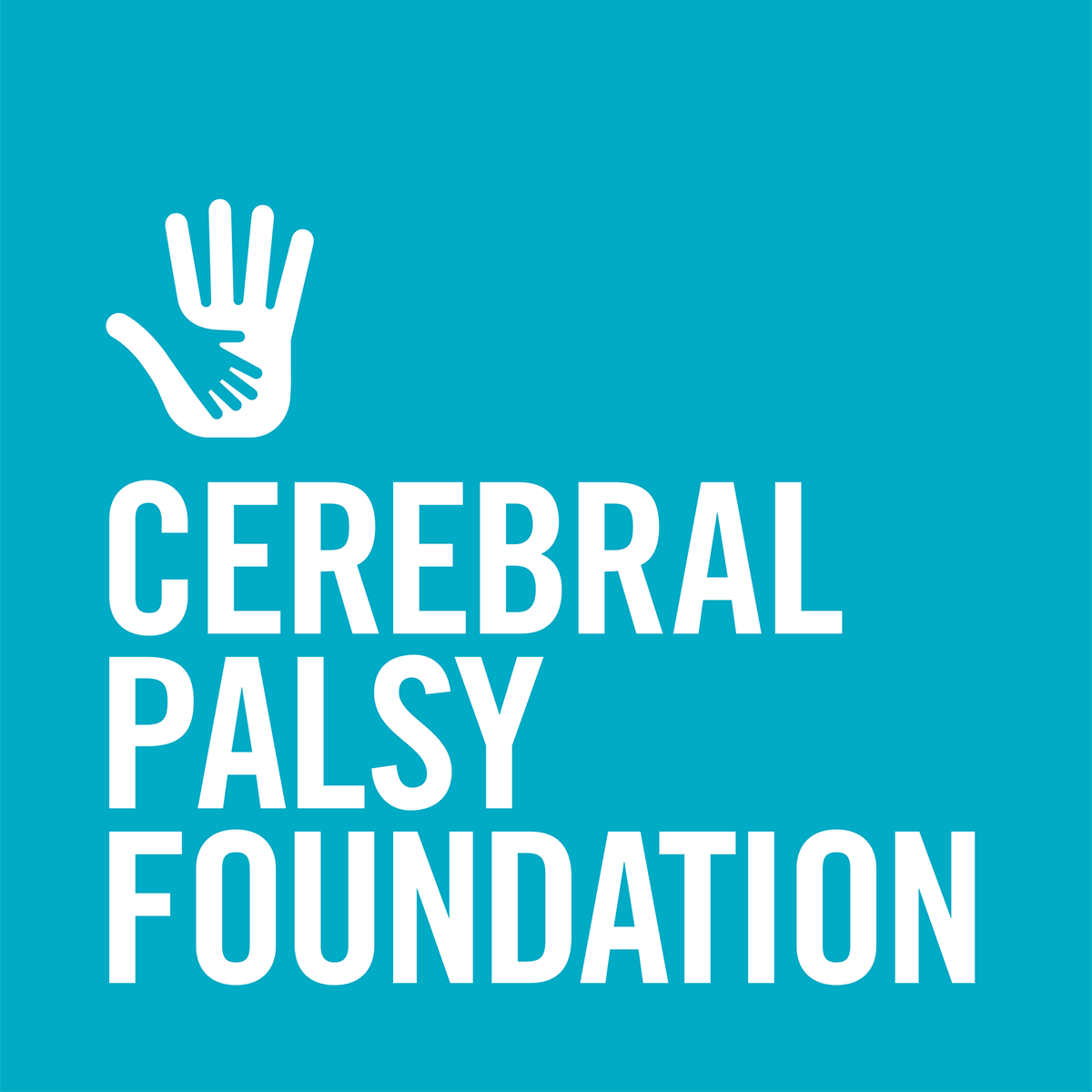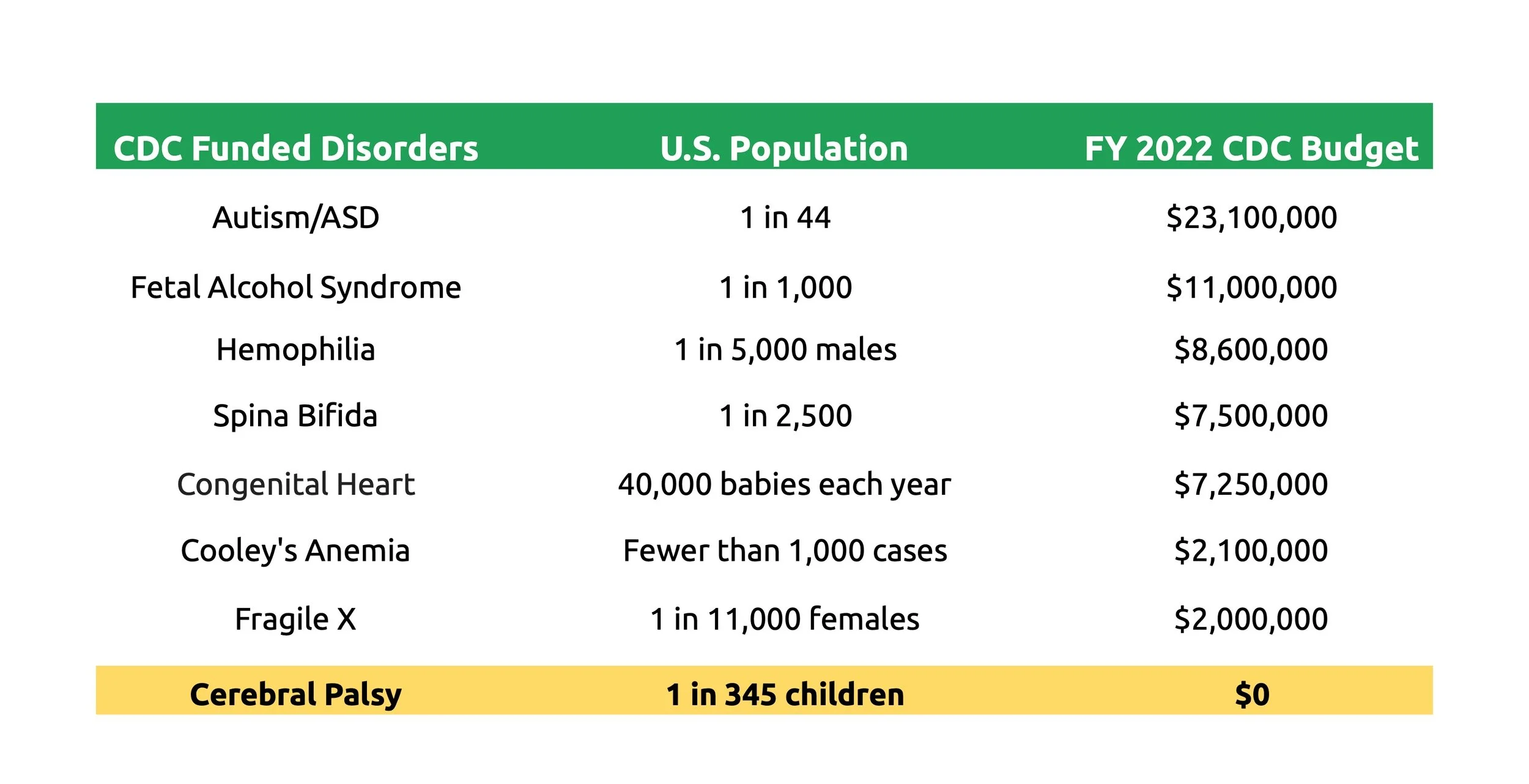Improved Public Health Outcomes for Cerebral Palsy FY24
The Cerebral Palsy Foundation continues its advocacy leadership urging Congress to prioritize federal investment in cerebral palsy research across the lifespan of people with cerebral palsy. We have continued to build from the significant success advocating for fiscal year 2023 Congressional report language that resulted in significant improvements in NIH cerebral palsy research focus and the vital addition of cerebral palsy back into the national Autism and Developmental Disability Monitoring Network (ADDM) in at least two existing sites. These legislative advances benefit the entire cerebral palsy community - stakeholders, families, researchers, healthcare providers and move the field forward to be able to create positive change, conduct more needed research and improve outcomes for people of all ages with cerebral palsy.
FY24 Labor Health and Human Services Draft Congressional Appropriations Report Language
Centers for Disease Control and Prevention (CDC):
Cerebral Palsy (CP) is the most common, lifelong physical disability caused by an early developmental brain injury affecting more than 1,000,000 Americans. The mechanism and type of injury underlying CP is still not well-understood, which can include prematurity, perinatal stroke, maternal infection, genetics and/or hypoxic ischemic encephalopathy (HIE). The Committee continues to support the inclusion of Cerebral Palsy in at least two of the Autism and Developmental Disabilities Monitoring Network (ADDM) sites; however, there is currently no federal research program to focus on this significant public health need. Therefore, the Committee directs the CDC to support research on the diagnosis, treatment, mitigation, health care costs, societal costs of cerebral palsy, and track the number of people diagnosed with CP in the United States across the lifespan.
Activities shall include population-based surveillance at US pilot sites to expand scientific knowledge on prevalence, risk factors, early detection and co-morbidities of cerebral palsy in order to determine if the cerebral palsy population is rising, dropping or staying the same.
National Institutes of Health (NIH):
The Committee directs the National Institutes of Health (NIH) to continue to prioritize and invest in research on cerebral palsy (CP) including the establishment of a Cerebral Palsy Notice of Special Interest (NOSI) to significantly strengthen and accelerate CP research priorities across the lifespan. The Cerebral Palsy NOSI should focus on basic and translational discoveries, as well as implementation science, observational, and clinical studies aimed at early detection and intervention, comparative effectiveness, and functional outcomes.
While some progress has been made in the understanding of CP, the most common lifelong physical disability, large gaps remain that must be addressed to improve outcomes and treatment for the cerebral palsy population and their families, impacting quality of life and reducing medical costs. Similarly, to address the racial and socioeconomic health equity challenges experienced by the cerebral palsy population, it is imperative that greater investment is made to address disparities in access to interventions and stakeholder engagement.
The Committee directs NIH to support greater investment in research focused on the areas in need of growth including research on lifespan issues to address the needs of transition-age youth and adults with cerebral palsy inclusive of mental health issues, as well as research to support the development and delivery of new and improved screening tools, treatments and interventions.
The Committee directs the National Institute of Mental Health (NIMH) to direct increased attention towards mental health in the cerebral palsy population. Studies indicate that adults with cerebral palsy have significantly higher age-standardized prevalence of mental health disorders compared to adults without cerebral palsy. Despite advances in the treatment of depression and other serious mental illnesses, there is little research and evidence-based interventions focused on the cerebral palsy population across the lifespan.
The Eunice Kennedy Shriver National Institute of Child Health and Human Development (NICHD) is also encouraged to consider a neuroplasticity workshop and research opportunities focusing on the motor and health benefits of physical activity specifically for individuals with CP across all Gross Motor Functional Classification levels which are so vital to help prevent chronic disease and premature aging.
FY23 Labor Health and Human Services Congressional Appropriations Report Language
Center for Disease Control (CDC)
Cerebral Palsy (CP) is the most common, lifelong motor disability caused by an early developmental brain injury. The mechanism and type of injury underlying CP is still not well-understood, which can include perinatal stroke, maternal infection, genetics and/or hypoxic ischemic encephalopathy (HIE). There is currently no federal program to focus on this significant public health need, therefore, the Committee provides $2,000,000 to the CDC to establish a National Cerebral Palsy Program to address the challenges of cerebral palsy across the lifespan. Activities shall include population-based surveillance at US pilot sites to expand scientific knowledge on prevalence, risk factors, early detection and co-morbidities of cerebral palsy in order to determine if the cerebral palsy population is rising, dropping or staying the same.
National Institutes of Health (NIH)
The Committee encourages the National Institutes of Health (NIH) to continue to prioritize and invest in research on cerebral palsy (CP) including the establishment of a Cerebral Palsy Notice of Special Interest (NOSI) to significantly strengthen and accelerate CP research priorities across the lifespan. The Cerebral Palsy NOSI should focus on basic and translational discoveries, as well as implementation, observational, and clinical studies aimed at early detection and intervention, comparative effectiveness, and functional outcomes.
While some progress has been made in the understanding of CP, the most common lifelong physical disability, large gaps remain that must be addressed to improve outcomes and treatment for the cerebral palsy population and their families, impacting quality of life and reducing medical costs. Similarly, to address the racial and socioeconomic health equity challenges experienced by the cerebral palsy population, it is imperative that greater investment is made to address disparities in access to interventions and stakeholder engagement. The Committee encourages NIH to support greater investment in research focused on the areas in need of growth, as outlined in the Strategic Plan on Cerebral Palsy Research directed by the FY22 Appropriations bill, including research on lifespan issues to address the needs of transition-age youth and adults with cerebral palsy, and research to support the development and delivery of new and improved screening tools, treatments and interventions.
The Eunice Kennedy Shriver National Institute of Child Health and Human Development (NICHD) is also encouraged to consider a neuroplasticity workshop and research opportunities focusing on the motor and health benefits of physical activity specifically for individuals with CP across all Gross Motor Functional Classification levels which is so vital to help prevent chronic disease and premature aging.
Why we need this funding and focus now
With dedicated federal research funding and focus, we can make strides toward determining causation, improving early detection and identifying the most effective treatments for cerebral palsy (CP) resulting in improved outcomes.
The prevalence of CP is NOT decreasing in the United States.
Currently, there is no consensus of “Best Practices” for a person with Cerebral Palsy at time of diagnosis or through the life span.
There are not organized standards of care or proven therapy protocols widely available like there are for adults who have a stroke, for example. Human brain neuroplasticity is now an accepted scientific fact revolutionizing the care of adults with a wide variety of brain injuries and diseases. It is illogical to think that older, injured brains can improve, but baby brains cannot.
Despite advances in prenatal and neonatal care, CDC indicates the prevalence of CP is as high as 3.6 per 1,000 U.S. 8 year- olds.
In contrast, the prevalence of CP is significantly lower, and is declining, in other countries such as Australia (1.4 live births) and Sweden (1.9 per 1,000 live births) due to better management of high-risk pregnancies, improvements in neonatal intensive care, earlier detection and intervention standards of care that are not being implemented in the U.S.
When Cerebral Palsy isn’t diagnosed until later in life, children and families often face significant and unnecessary challenges that could be prevented.
The financial burden of Cerebral Palsy on families and the healthcare system is exceedingly high.
It is estimated that the lifetime care and medical costs for all people with Cerebral Palsy who were born in 2000 alone will total more than $13.5 billion. The loss of productivity, lost wages of the individual with CP and their family members top $35 billion.
Investing in Cerebral Palsy research funding, with the goal of preventing and minimizing the impact of CP, would dramatically reduce these staggering costs and human suffering.
Most children and adults with CP need long-term medical care. The average lifetime additional direct cost for just one person with CP is estimated to be over $1.5 million more than someone who does not have CP - causing financial devastation in the struggle to afford treatment not covered by insurance. Federal and state governments in the form of Medicaid and other social services currently absorb much of this cost.
Since 2007, the CP community has increased focus on the need for federally funded Cerebral Palsy research.
Our community has come together to request answers to so many basic questions about a disorder and public health issue that impairs movement in more children than any other, and yet is not a federal research priority.










